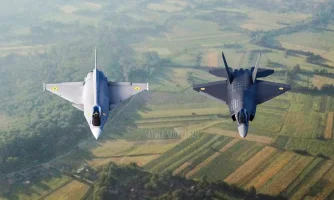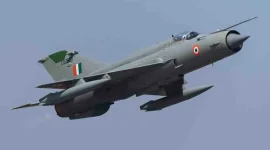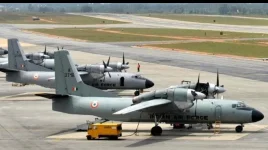- Views: 2K
- Replies: 23
The Indian Air Force (IAF) is currently navigating one of the most precarious periods in its history. Grappling with a depleted combat strength that has fallen to approximately 31 squadrons—well below the sanctioned strength of 42 needed for a two-front war—the force finds itself at a strategic crossroads.
In an attempt to reverse this decline, the IAF has drafted a procurement plan that resembles an ambitious, albeit disjointed, wishlist: additional Rafale jets for immediate impact, the indigenous Tejas Mk2 for volume, foreign fifth-generation stealth fighters from the US or Russia, and continued funding for the homegrown Advanced Medium Combat Aircraft (AMCA).
While this multi-pronged strategy aims to hedge geopolitical risks, defence analysts warn it borders on strategic incoherence. Spreading finite financial resources across competing programmes threatens to erode interoperability, inflate lifecycle costs, and invite endless delays.
Critics argue that unless the IAF prunes this portfolio to back one primary platform per generation, it risks creating a logistical nightmare that could ground the fleet just as adversaries begin to dominate the regional skies.
The Gathering Storm: A Squadron Deficit
The urgency of the situation is underscored by the rapid modernization of India’s neighbours.China’s People’s Liberation Army Air Force (PLAAF) has reportedly fielded over 300 J-20 stealth fighters as of late 2025, with production rates outstripping forecasts. Meanwhile, Pakistan continues to upgrade its JF-17 fleet and explore fifth-generation options.
In contrast, the IAF’s project to induct 450 new fighters over the next 15 years—at an estimated cost of $50–60 billion—risks delivering a "patchwork quilt" of platforms.
A fleet composed of French, Russian, American, and Indian aircraft would require separate training pipelines, distinct spare parts supply chains, and incompatible maintenance protocols, leading to what experts describe as disjointed warfighting capabilities.
The 4.5-Generation Dilemma: Imports vs. Indigenous
The IAF’s blueprint currently juggles immediate requirements with long-term indigenous goals.For its 4.5-generation needs, the force is pursuing the Multi-Role Fighter Aircraft (MRFA) tender for 114 jets, likely to be a "Made in India" variant of the Dassault Rafale or a competitor. This follows the 2016 purchase of 36 Rafales.
However, parallel to this, the Defence Research and Development Organisation (DRDO) is advancing the Tejas Mk2 programme. This heavier, more capable evolution of the indigenous Tejas is designed to be the future backbone of the IAF, with plans for over 200 units.
The problem lies in the redundancy. Both the Rafale and Tejas Mk2 are 4.5-generation stalwarts, yet they diverge significantly in design and logistics.
The Rafale’s delta-canard airframe requires French-specific simulators and electronic warfare suites, while the Tejas Mk2 utilizes American GE F414 engines and Indian Uttam AESA radars.
Operating both types extensively would fragment pilot training and maintenance pools. Studies suggest that such multi-type fleets can spike sustainment costs by 20–30%, effectively turning forward airbases into complex logistical hubs rather than streamlined fighting units.
The Fifth-Generation Fog
The confusion extends to the next generation of air dominance. The IAF has reportedly lobbied for the acquisition of foreign stealth fighters—such as the American F-35 or Russian Su-57—as an interim measure.Yet, the government has already committed significant resources to the AMCA, India’s sovereign stealth fighter project. In March 2024, the Cabinet Committee on Security (CCS) cleared ₹15,000 crore for the AMCA’s design and prototype development, with a target induction around 2034.
Importing an aircraft like the F-35, known for its closed software architecture, would clash with the AMCA’s open-architecture ambitions and divert critical funds away from domestic R&D.
Furthermore, reliance on Russian platforms like the Su-57 carries the risk of supply chain disruptions due to ongoing sanctions, a lesson learned painfully with the current spares shortage for the Su-30MKI fleet.
The Reality of Delays
The risks of a diversified, import-heavy strategy are compounded by persistent delays in existing programmes. The delivery of the Tejas Mk1A, an interim variant, has faced significant setbacks due to delays in the supply of F404 engines from US manufacturer General Electric.These delays recently prompted Air Chief Marshal AP Singh to publicly express his frustration, noting that "confidence has nosedived" regarding delivery timelines.
With the retirement of aging MiG-21s and the stretching of the Su-30 fleet, the IAF cannot afford further slippages. An approach that relies on multiple foreign vendors only increases the number of variables that can go wrong, from geopolitical sanctions to contract disputes.
A Case for Consolidation
Rationality dictates a more restrained approach: nominating one primary programme per generational rung to harvest economies of scale.- For the 4.5-generation: Doubling down on the Tejas Mk2 offers the most logical path. With high indigenous content and scalable production at HAL, it can replace aging fleets at a fraction of the cost of imported jets (approximately ₹200–250 crore per unit versus over ₹1,000 crore for imports).
- For the 5th-generation: The AMCA must remain the priority. Its success is existential for India’s goal of self-reliance by 2047.




